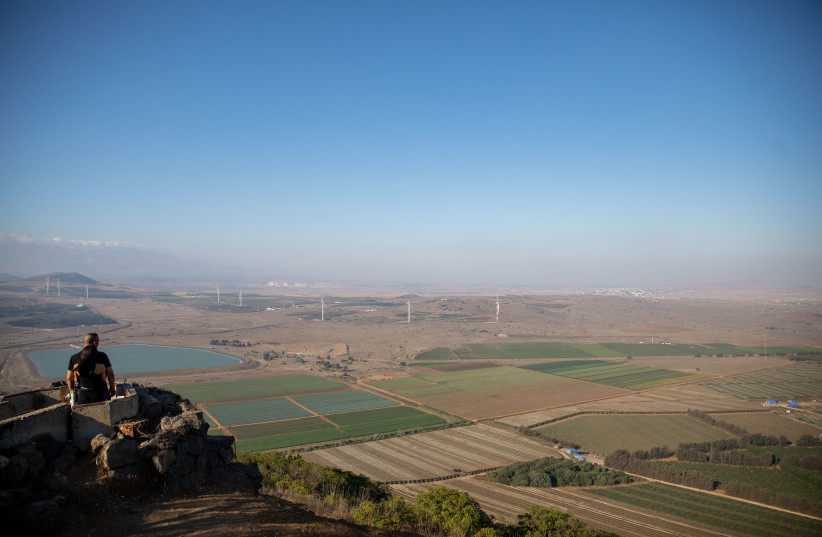The IDF said on November 17 that it had uncovered improvised explosive devices near the Alpha line, which forms part of the ceasefire line corridor on the Golan Heights
SETH J. FRANTZMAN

Last week a new round of Israeli airstrikes in Syria was announced as a kind of message to Iran. Iran has continued its entrenchment in Syria despite Israel’s opposition. It’s important to put this in context. Iran has been involved in Syria for years. Tehran’s alliance with the Syrian regime is not a new phenomenon. However the civil war in Syria weakened the Syrian regime and enabled Iran to expand its direct role and to feed off the chaos by bringing Hezbollah in to take up ungoverned spaces in Syria. Were the airstrikes a new phase, or just more of the same?
The IDF said on November 17 that it had uncovered improvised explosive devices near the Alpha line, which forms part of the ceasefire line corridor on the Golan Heights.In response Israel conducted airstrikes against the Iranian IRGC Quds Force in Syria. Israel said that its assessment was that Syrian locals with guidance and control by the Iranian IRGC had planted the device. This happened before in August. Iran and its allies didn’t get the message apparently. Israel wants the Syrian regime to stop tolerating Iran’s infiltration and entrenchment. Prime Minister Benjamin Netanyahu and others have all been warning Iran for years, going back to 2018 when the Syrian regime reconquered the area.
In fact the IED planted in mid-November was planted near the area where Israel had conducted its aid deliveries to Syrians during the conflict between 2012 and 2018. It’s not clear if Iran’s message was related to this area specifically but symbolically it shows how the border area turned from one of peace to threat. Since the 1970s the Assad regime has assessed that it could not threaten Israel from this area and had largely given up hopes of destroying Israel, despite regime rhetoric. Presidential daily briefs, from the US intelligence community, had affirmed this change in reality in Damascus. This means that the weakening of the regime enabled Iran to go deeper into Syria and begin to threaten Israel more seriously in a manner the regime may not have tolerated before.
It appears Israel’s assessment was that a message to the regime and Iran is the way to get this to stop. Israel’s de-confliction discussions with Russia since 2015 have helped make sure that there are no incidents with Russia. But rumors that Russia would somehow keep Iran away from the Golan, at a distance of some 60 kilometers, were never met with reality in 2018 or after. In the fall of 2018 an Israeli airstrike in Latakia in northern Syria led Syrian air defense to fire wildly and down a Russian plane. Russia said it would give Damascus the S-300, but Russia didn’t seem to follow through. Iran even tried to move its 3rd Khordad system to Syria. That system was allegedly destroyed on a tarmac in T-4 base in 2018.
This brings us to where we are today. Ron Ben-Yishai at Ynet writes that IDF airstrikes were a clear warning to Tehran. Iran is seeking a new strategic challenge via Syria, the report notes. This includes an agreement between Iran and Syria that would enable the transfer of “state-of-the-art air defense designed to combat Israeli aerial attacks.”
Messages via airstrike are notoriously complex. While Carl von Clausewitz, the Prussian military thinker, is credited with arguing that war and diplomacy and politics are related, it is not always clear how messages conveyed by precision guided bombs and missiles will lead the Iranian to react. The regime in Tehran is waiting out the last months of the Trump administration. It knows what Israel is capable of but it has also been investing in Syria for years, testing to see where it can build and where it can’t. It has sent drone teams, missiles, factories, militias, and all manner of ordnance to Syria.
Now it must wonder if this is a new era in Syria, or if it will bide its time. It views the struggle with Israel as a long term battle against the US, Israel and allies. It feels confident it has digested Syria, Lebanon, Iraq and Yemen.
if(window.location.pathname.indexOf(“647856”) != -1) {console.log(“hedva connatix”);document.getElementsByClassName(“divConnatix”)[0].style.display =”none”;}
Content retrieved from: https://www.jpost.com/arab-israeli-conflict/is-there-a-new-phase-for-iran-in-syria-649875?fbclid=IwAR14e4kG9zcPFZH0lO4fsmdhM4EjWJNIRW1WB9hMUdKIlabz3VAqyOB4Ils.